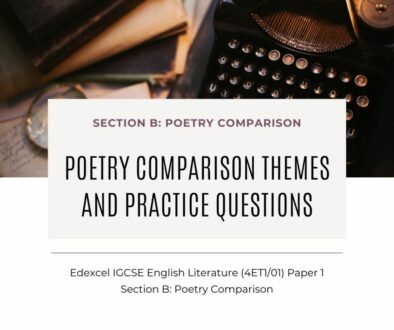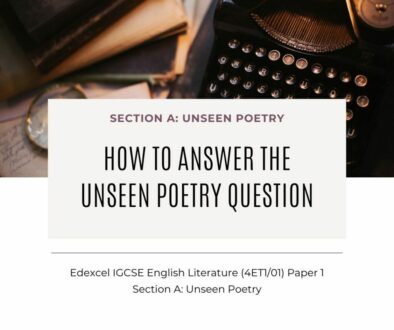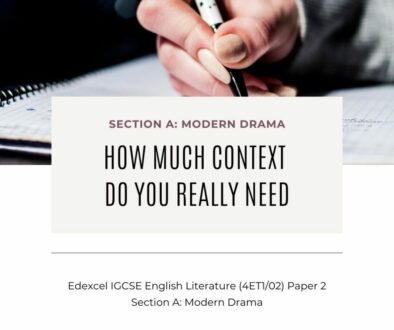17 Essential Poetic Devices for GCSE and IGCSE English Literature
Success are GCSE and IGCSE English Literature—especially in the unseen poetry section—relies on understanding what a poem says, and also how it says it. The secret here lies in mastering the literary techniques poets use to shape meaning, mood, and message.
This guide introduces seventeen of the most important poetic devices for GCSE students. For each, you’ll find:
- A clear, concise definition
- The purpose and effect of the technique in a poem
- Tips on how to recognise it in an exam
- A real poetry example, including poems from common GCSE syllabuses
- A brief model analysis showing how to discuss the device in your writing
Whether you’re preparing for Edexcel, AQA, or OCR, this guide is designed to strengthen your analytical skills, improve your confidence with unseen texts, and help you meet the top-level assessment objectives. Use it as a revision resource, a classroom reference, or a companion during practice exam responses.
Edexcel English Literature IGCSE Poetry:
Edexcel English Literature IGCSE (4ET1/01) Paper 1 – Past Exam Questions – Unseen Poetry
Edexcel English Language A iGCSE (4EA1/02) Paper 2 – Poetry and Prose Text Past Exam Questions
Section A Unseen Poetry Compiled Exam Questions
Edexcel IGCSE English Literature: How to Answer the Unseen Poetry Question (this article)
Section B Anthology Poetry Compiled Exam Questions
Anthology Poetry Exam Questions
Edexcel IGCSE English Literature: How to Answer the Poetry Comparison Question
Section C Modern Prose Compiled Exam Questions
- To Kill a Mockingbird, Harper Lee
- Of Mice and Men, John Steinbeck
- The Whale Rider, Witi Ihimaera
- The Joy Luck Club, Amy Tan
- Things Fall Apart, Chinua Achebe
A Complete Guide with Definitions, Real Examples, and Analytical Insights
1. Alliteration
Definition:
Alliteration is the repetition of the same consonant sound at the beginning of closely connected words.
Why Writers Use It:
Alliteration draws attention to key phrases and creates rhythm or mood. It can make an image more vivid or mirror the tone—harsh, soft, playful, or aggressive—depending on the consonant used.
How to Spot It in an Exam:
Look for words close together that begin with the same letter sound, especially at the start of lines or stanzas. Ask: does the sound reflect the mood or reinforce a theme?
Example from a Poem:
“And the silken sad uncertain rustling of each purple curtain” – The Raven, Edgar Allan Poe
Analysis:
The repeated ‘s’ sounds double as alliteration and sibilance, creating a whispering, mysterious atmosphere. It enhances the sense of unease and mirrors the speaker’s creeping anxiety.
2. Anaphora
Definition:
Anaphora is the repetition of a word or phrase at the beginning of successive lines or clauses.
Why Writers Use It:
This device adds emphasis and structure to a poem. It can express obsession, intensity, or persistence—mirroring the speaker’s emotional state.
How to Spot It in an Exam:
Look at how lines or clauses begin. If you notice a repeated word or phrase at the start of multiple lines, it’s likely anaphora. Ask: What emotion or message is the repetition amplifying?
Example from a Poem:
“What the hammer? what the chain?” – The Tyger, William Blake
Analysis:
The repetition of “what” reflects the speaker’s awe and fear. The persistent questioning builds rhythm and suspense, mirroring the speaker’s internal turmoil and philosophical wonder.
3. Assonance
Definition:
Assonance is the repetition of vowel sounds in nearby words, typically within the middle of words.
Why Writers Use It:
Assonance creates musicality and fluidity. Depending on the vowel sound, it can evoke softness, melancholy, or urgency.
How to Spot It in an Exam:
Listen for repeated vowel sounds, especially in the middle of words. Ask: What tone does this repetition support? Is it soothing, eerie, emotional?
Example from a Poem:
“Hear the mellow wedding bells” – The Bells, Edgar Allan Poe
Analysis:
The long ‘e’ and ‘o’ sounds produce a lilting, musical tone that reflects celebration and joy. It aligns perfectly with the poem’s subject—the harmonious ringing of bells.
4. Caesura
Definition:
Caesura is a strong pause within a line of poetry, often marked by punctuation like commas, dashes, or full stops.
Why Writers Use It:
It can mimic natural speech, show hesitation, or reflect a speaker’s inner conflict. It breaks the flow intentionally to highlight a key thought or shift.
How to Spot It in an Exam:
Look for mid-line punctuation. Ask: Why does the poet interrupt the flow here? Does it reflect emotion, doubt, or a turning point?
Example from a Poem:
“To be, or not to be – that is the question.” – Hamlet, William Shakespeare
Analysis:
The dash signals a moment of reflection or pause. It mirrors the speaker’s indecision and deep existential questioning, heightening the dramatic tension.
5. Enjambment
Definition:
Enjambment is when a sentence or clause continues from one line to the next without a pause or punctuation.
Why Writers Use It:
It creates momentum, mirrors natural speech, or suggests emotional overflow. It can also reflect chaos or continuity, depending on context.
How to Spot It in an Exam:
If a line runs on into the next without punctuation, that’s enjambment. Ask: Is the flow urgent, emotional, or deliberate? What does it say about the speaker’s state of mind?
Example from a Poem:
“I think that I shall never see / A poem lovely as a tree.” – Trees, Joyce Kilmer
Analysis:
The line flows smoothly into the next, reflecting a calm and meditative tone. The enjambment adds to the poem’s gentle rhythm and reverent appreciation for nature.
6. Hyperbole
Definition:
Hyperbole is deliberate and obvious exaggeration used for emphasis or effect.
Why Writers Use It:
It intensifies emotions, draws attention to the speaker’s passion or desperation, and can create drama or humour. It’s not meant to be taken literally—its power lies in its boldness.
How to Spot It in an Exam:
Watch for claims that are physically or logically impossible. Ask: What emotion is this exaggeration trying to magnify? Love, sorrow, anger?
Example from a Poem:
“Till the ocean is folded and hung up to dry” – A Red, Red Rose, Robert Burns
Analysis:
This impossible image expresses the boundless, eternal nature of the speaker’s love. The exaggeration deepens the emotional intensity and helps convey an almost mythical level of devotion.
7. Imagery
Definition:
Imagery involves vivid and descriptive language that appeals to the five senses: sight, sound, smell, touch, and taste.
Why Writers Use It:
Imagery paints pictures in the reader’s mind and can evoke mood, atmosphere, and emotional depth. It immerses the reader in the poem’s world.
How to Spot It in an Exam:
Look for sensory-rich descriptions. Ask: What senses are being targeted? How does this affect the reader’s emotional response?
Example from a Poem:
“The moon was a ghostly galleon tossed upon cloudy seas” – The Highwayman, Alfred Noyes
Analysis:
This powerful visual metaphor turns the sky into a stormy ocean and the moon into a ship. The imagery creates a moody, romantic, and suspenseful atmosphere at the poem’s outset.
8. Irony
Definition:
Irony is when the intended meaning contrasts sharply with the literal meaning, or when expectations are subverted.
Why Writers Use It:
It can add layers of meaning, highlight hypocrisy, or provoke thought. Irony often delivers social critique or emotional twist with subtle power.
How to Spot It in an Exam:
Ask: Does what’s said or described contrast with what’s expected? Is there a tension between surface and subtext?
Example from a Poem:
“The marriage hearse” – London, William Blake
Analysis:
Blake juxtaposes symbols of joy and death—marriage and a hearse. The irony criticises a society where even sacred institutions like marriage are tainted by corruption and decay.
9. Juxtaposition
Definition:
Juxtaposition places two contrasting ideas, characters, or images side by side.
Why Writers Use It:
It highlights differences and creates tension, contrast, or surprise. This contrast can reveal character traits, themes, or societal commentary.
How to Spot It in an Exam:
Look for opposites placed together—light/dark, innocence/experience, joy/suffering. Ask: What does the contrast reveal or intensify?
Example from a Poem:
“In every cry of every Man, / In every Infant’s cry of fear” – London, William Blake
Analysis:
Blake places the suffering of men and infants side by side to show the pervasiveness of misery across all ages. The juxtaposition amplifies the poem’s bleak tone and indictment of social injustice.
10. Metaphor
Definition:
A metaphor is a direct comparison between two unrelated things, stating that one is the other.
Why Writers Use It:
Metaphors create strong imagery and can condense complex ideas into powerful visual or emotional associations.
How to Spot It in an Exam:
If something is described as being something else—not just like it—then it’s a metaphor. Ask: What deeper idea or feeling is being communicated?
Example from a Poem:
“All the world’s a stage” – As You Like It, William Shakespeare
Analysis:
This metaphor transforms life into performance, people into actors. It invites the reader to reflect on identity, roles, and the nature of existence—delivering a philosophical depth in just a few words.
11. Onomatopoeia
Definition:
Onomatopoeia refers to words that imitate the natural sound of the thing they describe.
Why Writers Use It:
It enhances the sensory experience of a poem—especially sound—and can bring scenes to life. It helps the reader “hear” the action or environment.
How to Spot It in an Exam:
Look for sound words like buzz, crash, whisper, or murmur. Ask: How does the sound contribute to the mood or action?
Example from a Poem:
“The murmuring of innumerable bees” – The Princess, Alfred Lord Tennyson
Analysis:
The word “murmuring” mimics the soft, continuous buzz of bees. It creates a tranquil, almost hypnotic atmosphere, reflecting nature’s quiet industry.
12. Personification
Definition:
Personification is when human qualities are given to animals, objects, or abstract concepts.
Why Writers Use It:
It makes descriptions more vivid and relatable, helping readers emotionally connect with non-human elements.
How to Spot It in an Exam:
Look for actions, emotions, or intentions described in non-human things. Ask: What does giving this thing human traits add to the meaning?
Example from a Poem:
“Because I could not stop for Death – / He kindly stopped for me” – Because I could not stop for Death, Emily Dickinson
Analysis:
Death is personified as a polite, gentlemanly figure. This unusual depiction challenges the reader’s fear of mortality and creates a calm, eerie tone.
13. Repetition
Definition:
Repetition involves deliberately repeating a word or phrase for emphasis or effect.
Why Writers Use It:
It reinforces themes, creates rhythm, or mimics emotional fixation. Repetition can imitate obsession, anxiety, or power.
How to Spot It in an Exam:
Repeated words or lines—ask: What is the speaker fixated on, and how does it reinforce the message?
Example from a Poem:
“Nevermore” – repeated throughout The Raven, Edgar Allan Poe
Analysis:
The repeated word grows in power and despair as the poem progresses. It mimics the speaker’s spiralling mental state and sense of finality.
14. Rhyme Scheme
Definition:
Rhyme scheme refers to the ordered pattern of rhyming sounds at the ends of lines (e.g., ABAB, AABB).
Why Writers Use It:
Rhyme schemes create musicality, order, and structure. Variations in rhyme can signal a mood shift or a break in control.
How to Spot It in an Exam:
Label the end words of each line (A, B, etc.). Ask: Is the pattern regular or disrupted? What’s the effect?
Example from a Poem:
“She walks in beauty, like the night / Of cloudless climes and starry skies; / And all that’s best of dark and bright / Meet in her aspect and her eyes.” – She Walks in Beauty, Lord Byron
Analysis:
The ABAB pattern gives the poem a smooth, elegant rhythm, reflecting the beauty and harmony it describes. The consistency enhances the poem’s gentle admiration.
15. Sibilance
Definition:
Sibilance is the repetition of soft consonant sounds, especially ‘s’, ‘sh’, or ‘z’.
Why Writers Use It:
Depending on context, it can soothe, haunt, or intensify mood. It mimics whispering, hissing, or flowing water.
How to Spot It in an Exam:
Underline clusters of ‘s’, ‘sh’, or ‘z’ sounds. Ask: What mood does this sound produce? Calm? Sinister? Secretive?
Example from a Poem:
“And the silken sad uncertain rustling of each purple curtain” – The Raven, Edgar Allan Poe
Analysis:
The sibilance creates a hushed, eerie effect, echoing the poem’s suspenseful tone. It mimics the soft sounds of movement, contributing to a feeling of ghostly presence.
16. Simile
Definition:
A simile is a comparison between two different things using “like” or “as”.
Why Writers Use It:
It helps readers understand unfamiliar concepts by comparing them to known ideas. It also creates vivid, imaginative descriptions.
How to Spot It in an Exam:
Scan for “like” or “as” used in a comparison. Ask: What’s being compared, and what does the comparison reveal?
Example from a Poem:
“My love is like a red, red rose” – A Red, Red Rose, Robert Burns
Analysis:
The simile links love to a rose, suggesting it’s natural, beautiful, and passionate—but also potentially fragile or fleeting.
17. Volta
Definition:
A volta is a shift or turning point in a poem’s tone, argument, or theme—especially in sonnets.
Why Writers Use It:
It marks a change in direction or introduces a resolution. The volta can surprise the reader, offer insight, or contrast previous lines.
How to Spot It in an Exam:
In sonnets, it usually occurs at line 9. Elsewhere, look for a clear shift in tone or topic. Ask: What has changed, and why?
Example from a Poem:
“And yet, by heaven, I think my love as rare / As any she belied with false compare.” – Sonnet 130, William Shakespeare
Analysis:
After mocking conventional beauty standards, the speaker shifts tone in the final couplet. The volta reveals sincere love, untouched by clichés, offering a powerful emotional contrast.
Conclusion
A strong understanding of poetic devices is essential for success in GCSE and IGCSe English Literature. By recognising how poets use language, form, and structure, you can build more thoughtful, precise, and insightful exam responses. The techniques outlined in this guide are tools that poets have used effectively and when you master them, you strengthen your skills and ability for interpretation and expression. Regardless of whether you are revising for the unseen poetry section or building confidence in your literary analysis, come back to these examples often and practise applying them in your own writing. The more familiar you become with these devices, the more clearly you will see the meaning and craft within every poem you read.














